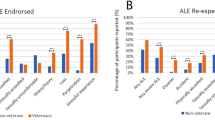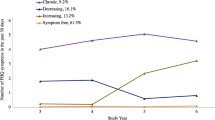Summary
This study examined the relationships of life events and social integration with combat-related Post-traumatic stress disorder. The sample consisted of 255 Israeli soldiers who suffered a combat stress reaction episode during the 1982 Lebanon War and were followed one and two years after their participation in combat. Statistical analyses yielded significant effects of positive and negative life events and social integration on the diagnosis of post-traumatic stress disorder. Changes in the diagnosis of post-traumatic stress disorder from time 1 to time 2 were associated with life events and social integration. Theoretical and methodological implications of the findings were discussed.
Similar content being viewed by others
References
American Psychiatraic Association (1980) Diagnostic and statistical manual of mental disorders, DSM-III (3rd edn). American Pschiatric Association Washington DC
Aro G, Hanninen V (1984) Life events or life processes as determinants of mental strain? A 5-year follow-up study. Soc Sci Med 18: 1037–1044
Brown GW, Birley JLT (1968) Crisis and life changes and the onset of schizophrenia. J Health Soc Behav 9: 203–214
Brown GW, Harris T (1978) Social origins of depression: a study of psychiatric disorders in women. Free Press, New York
Burgess AW, Holmstrom LL (1974) Rape: victims of crisis. Robert J Brady Bowie, MD
Caplan G (1974) Support systems and community mental health. Behavioral Publications, New York
Chiriboga D (1977) Life events weighting systems: a comparative analysis. J Psychosom Res 21: 415–422
Christenson RM, Walker JL, Ross DR, Malthie AA (1981) Reactivation of traumatic conflicts. Am J Psychiatry 138: 984–985
Coates D, Wortman CB (1980) Depression maintenance and interpersonal control. In: Baum A, Singer JE (eds) Advances in environmental psychology, vol 2. Erlbaum Hillsdale, NJ, pp 149–182
Cohen EA (1953) Human behavior in the concentration camp. Corsset & Dunlap, New York
Cohen J, Cohen P (1975) Applied multiple regression/correlation analysis for the behavioral sciences. Erlbaum Hillsdale,
Cohen LE, McGowan J, Fooskas S, Rose S (1984) Positive life events and social support and the relationship between life stress and psychological disorders. Am J Community Psychol 12: 567–587
Cohen S, Ashby-Wills T (1985) The stress buffering hypothesis of social support. Psychol Bull 98: 310–357
Cohen S, Hoberman H (1983) Positive events and social support as buffers of life change stress. J App] Soc Psychol 13: 99–125
Coyne JC (1976) Toward an interactional description of depression. Psychiatry 39: 28–40
Dohrenwend BS, Dohrenwend BP (1978) Some issues in research of stressful life events. J Nerv Merit Dis 166: 7–15
Frye JS, Stockton RA (1982) Discriminant analysis of posttraumatic stress disorder among a group of Vietnam veterans. Am J Psychiatry 139: 52–56
Gersten JC, Langner TS, Eisenberg JG, Orsek L (1974) Child behavior and life events: undesiderable change or change perse? In: Dohrenwend BS, Dohrenwend BP (eds) Stressful life events. Wiley, New York, pp 159–170
Grinker RR, Spiegel JP (1945) Men under stress. Blakistan, Philadelphia
Hinkle LE (1974) The effects of exposure to culture change, social change, and changes in interpersonal relationships on health. In: Dohrenwend BS, Dohrenwend BP (eds) Stressful life events. Wiley, New York, pp 944–969
Holmes TH, Rahe RH (1967) The social readjustment rating scale. J Psychosom Res 11: 213–218
Kardiner A (1947) War stress and neurotic illness. Haeber, New York
Laufer RS, Yager T, Frey-Wouters E, Donellan J (1981) Postwar trauma: social and psychological problems of Vietnam veterans and their peers. Legacies of Vietnam, vol 111. Governmental Printing Office Washington DC
Lazarus R, Kanner A, Folkman S (1980) Emotions: a cognitive phenomenological analysis. In: Plutchnick R, Kellerman H (eds) Theories of emotions. Academic Press, New York
Lifton RJ (1973) Home from the war. Sunam & Schuster, New York
Markush RE, Favero RV (1974) Epidemiological assessment of stressful life events, depressed mood and psychophysiological symptom: A preliminary report. In: Dohrenwend BS, Dohrenwend BP (eds) Stressful life events. Wiley, New York, pp 171–190
Mueller DP, Edwards DW, Yarvis RM (1977) Stressful life events and psychiatric symptomatology: change or undesiderability. J Health Soc Behav 18: 307–317
Murrell JA, Norris FH (1983) Resources, life events, and changes in psychological states. J Community Psychol 11: 473–491
Nelson D, Cohen LH (1983) Locus of control and control perceptions and the relationship between life stress and psychological disorders. Am J Community Pschol 11: 705–722
Paykel EJ (1979) Contribution of life events to causation of psychiatric illness. Psychol Med 8: 245–253
Rabkin JG, Struening EL (1976) Life events, stress, and illness. Science 194: 1013–1020
Rahe RH, Arthur RJ (1978) Life changes and illness studies: past history and future directions. J Human Stress 4: 3–15
Ross CE, Mirowsky JA (1979) A comparison of life events weighting schemes: change, undesiderability, and effect-proportional indices. J Health Soc Behav 20: 166–177
Sarason I, Johnson J, Siegel J (1978) Assessing the impact of life changes: development of the life experiences survey. J Consult Clin Psychol 46: 932–946
Solomon Z, Weisenberg M, Schwarzwald J, Mikulincer M (1987) Post-traumatic stress disorder among front-line soldiers with combat stress reaction: the 1982 Israeli experience. Am J Psychiatry 144: 448–454
Titchener JL, Ross WD (1974) Acute or chronic stress as determinants of behavior, character and neurosis. In: Arieti S, Brody EB (eds) Adult clinical psychiatry: American handbook of psychiatry, vol 3. Adult clinical psychiatry (2nd edn). Basic Books, New York, pp 39–60
Vinokur A, Selzer M (1975)Desiderable versus undesiderable life events: their relationship to stress and mental distress. J Pets Soc Psychol 32: 329–337
Williams A, Ware J, Donald C (1981) A model of mental health, life events, and social support applicable to general populations. J Health Soc Behav 22: 324–336
Zautra A, Reich J (1983) Life events and perceptions of life quality: developments in a two-factor approach. J Community Psychol 11: 121–132
Author information
Authors and Affiliations
Rights and permissions
About this article
Cite this article
Solomon, Z., Mikulincer, M. & Flum, H. The implications of life events and social integration in the course of combat-related post-traumatic stress disorder. Soc Psychiatry Psychiatr Epidemiol 24, 41–48 (1989). https://doi.org/10.1007/BF01788199
Accepted:
Issue Date:
DOI: https://doi.org/10.1007/BF01788199




